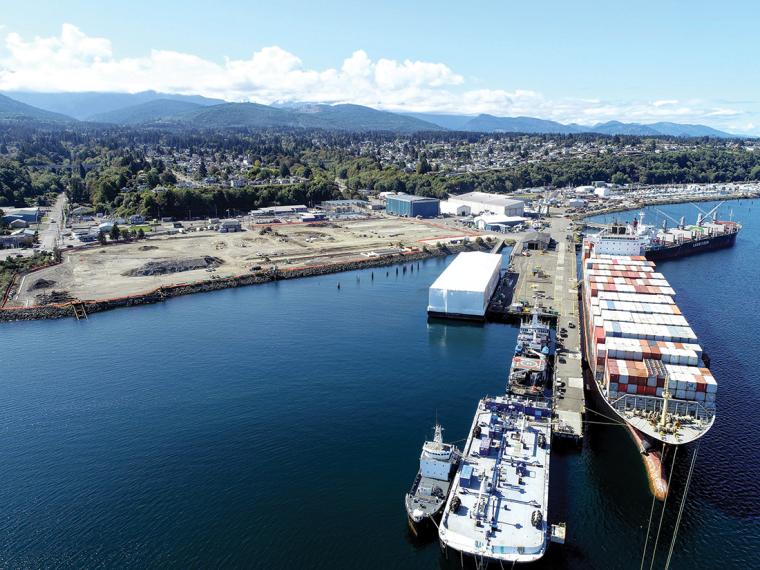
The United States port system is a critical component of a growing national economy, and ports remain the backbone of the nation ís intermodal transportation system. In fact, more than 95 percent of the cargo entering the U.S. arrives by ship into one of more than 360 commercial ports nationwide. From these ships, goods are transported by truck, air or rail to their destinations in communities across the nation.
Port of Brownsville, Texas
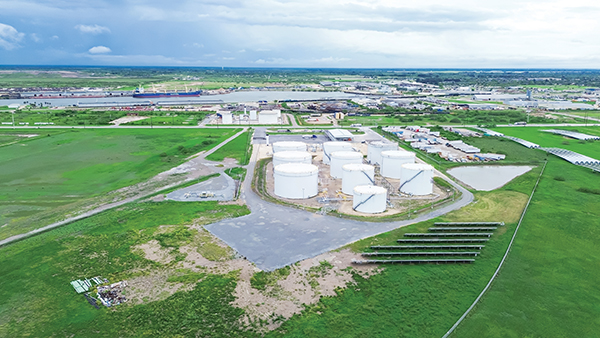
The Port of Brownsville is the only deepwater port located on the U.S.-Mexico Border. With approximately 40,000 acres of land available for development and 17 miles of waterfront access, the port offers a direct route to non-congested international bridge crossings and rail connections.
The Port of Brownsville handles a wide variety of cargo including steel products, liquid, break bulk and dry bulk commodities. With the facilities and knowledge to handle international cargo, the port facilitates efficient movement of goods between the United States and Mexico and is strategically positioned to serve and connect industries across North America and beyond. The port is a prominent shipper of steel, refined petroleum products, grain, aggregates and other products.
Convenient and efficient commercial border crossings are located seven miles from the port by truck or about 13 miles by railroad at the West Rail Bridge. Class 1 rail service to and from the port to Mexico and all of North America includes Canadian Pacific Kansas City for operations south of the border, and Union Pacific and BNSF Railway serving northern routes.
The Port of Brownsville is a vital asset to the regional economy. According to the USACE 2022 annual report, the Port of Brownsville ranked 50th among 150 U.S. maritime ports for waterborne cargo, handling 9.1 million tons in 2022. The port witnessed a banner year in 2023 with 17.8 million tons of cargo moving through the port’s docks, a 17 percent year-over-year increase.
The Port of Brownsville is in the process of constructing a 118-acre shovel-ready business park. The development offers 17 lots with all utilities, a foreign trade zone, direct access to the USMCA corridor, connection to three Class 1 railroads and direct access to the port’s overweight corridor. The park is the ideal setting for light to medium manufacturing operations across diverse industries.
In December 2024, the Brownsville Navigation District (BND) and the U.S. Army Corps of Engineers (USACE) held a groundbreaking ceremony for Phase 2 of its Brazos Island Harbor (BIH) Channel Improvement Project. The project will deepen the 17-mile-long Brownsville Ship Channel from 42 feet to 52 feet, improving navigational safety and enabling larger commercial vessels to access South Texas.
“The BIH groundbreaking ceremony marks a milestone in our journey to shape the Port of Brownsville’s future,” said Port of Brownsville Director and CEO William Dietrich. “With the BIH project, we are strengthening our role as a catalyst for business growth and demonstrating our responsibility to the community by transforming the port into a dynamic hub for value-added industries.”
Port Fourchon, Louisiana
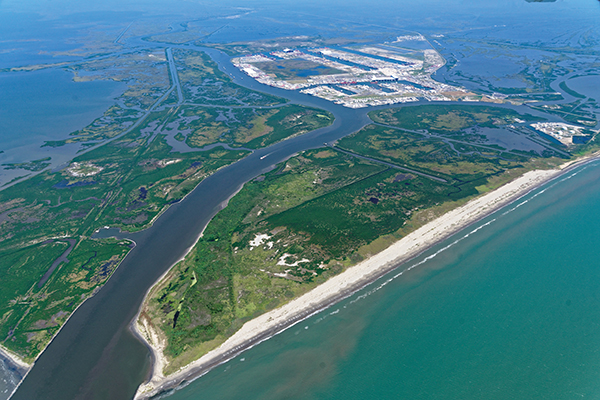
Port Fourchon is comprised of more than 1,700 acres of developed land with over 90,000 linear feet of waterfront property that house state-of-art facilities. The port is home to more than 90 different tenant companies that hold more than 140 leases. Port Fourchon is a service supply port that plays a pivotal role in servicing nearly 100 percent of the Gulf of Mexico’s deepwater energy production.
From an economic development perspective, five of the top 10 Lafourche Parish employers operate from and/or use Port Fourchon. If access in and out of Port Fourcon is interrupted, the impact to the Nation’s GDP is upwards of $500 million per day.
Port Fourchon has an airport known as the South Lafourche Leonard Miller, Jr. Airport located in Galliano. This General Aviation airport is of strategic economic importance and serves as the base of operations for Chevron, Bristow Search and Rescue and RLC. A substantial amount of acreage surrounding the airport is slated for industrial development of aviation-related businesses and companies supporting offshore energy activities at Port Fourchon and in the Gulf of Mexico.
A long-term lease has been established with Argent LNG, which will eventually bring about a facility that would provide up to 20 MTPA at Port Fourchon. Besides this, Port Fourchon will become home to the first wind turbine in the state of Louisiana in 2025. This test turbine is expected to provide valuable data for examination as Port Fourchon readies itself for the potential of servicing offshore wind in the future.
This is considered an “energy addition” to Port Fourchon’s portfolio, as the port continues to play an irreplaceable role in servicing oil and gas. Furthermore, the Fourchon Island development will operate as a deepwater port facility allowing for deepwater rig repair and refurbishment, project cargo, decommissioning, fabrication, offshore wind component storage and more.
Port Fourchon is a service supply port so the goods that come through the port are more related to drilling muds, fluids, wiring, etc. These items are used to load on to the vessels that service the deepwater Gulf of Mexico.
“The Greater Lafourche Port Commission’s staff and its distinguished Board of Commissioners that help oversee Port Fourchon take our roles seriously because we understand how the port is an economic engine for not only our parish (Lafourche), but the entirety of Louisiana as well,” said GLPC Executive Director Chett Chiasson. “When you take our tenants’ and users’ current efforts in servicing the oil and gas industry and combine this with the many emerging opportunities in the energy sector at large, it’s obvious that Port Fourchon is best suited to be an ideal servicer of all of the above, serving our region and the country as they move into the future.”
Port Freeport, Texas
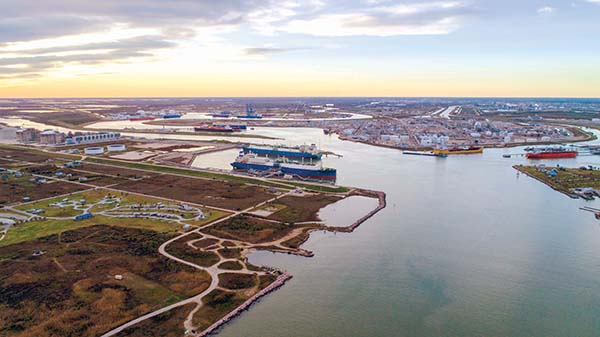
Port Freeport is located in Brazoria County, Texas, about one hour south of downtown Houston, and is a self-governing body of the State of Texas. Port Freeport is a navigation district and local sponsor of the Freeport Harbor Channel, which serves public and private facilities. In general, Port Freeport is a liquid bulk export port with private terminals capable of handling energy and petrochemical products. The port’s public facilities handle only dry goods, primarily containerized, breakbulk, bulk, project and roll-on/roll-off (RORO) cargoes. As of 2022, Port Freeport supports 109,800 direct, indirect and induced jobs statewide. In 2023, Port Freeport ranked 17th nationally for total foreign waterborne tonnage handled.
In 2024, the Port Commission voted to adopt a zero tax rate. This represents the first time in Port Freeport’s history that it will be self-reliant, and no taxes will be assessed.
“The recent growth at the port has greatly bolstered our operating revenues, enabling the port to fully sustain operations while meeting the debt service requirements on all outstanding bonds, including voter-approved issues. We are very thankful to the taxpayers who have supported the port for nearly 100 years, but we will take it from here,” said Vice Chairman and Finance Committee Chair Rob Giesecke.
In June of 2024, Port Freeport welcomed the M/V Delmonte Spirit to its Velasco Container Terminal during its first call to Port Freeport. Del Monte Fresh Produce N.A. completed a partial retrofit of the port’s Velasco Container terminal and installed 688 electrical receptacles to receive imported fruit from their weekly vessel service.
Also in 2024, Port Freeport announce the execution of a lease agreement with Chiquita Fresh North America, marking a milestone in their ongoing partnership. Effective in June of 2024, the parties have agreed to a five-year lease term with an option to extend the agreement for an additional five years.
Port of Lake Charles, Louisiana
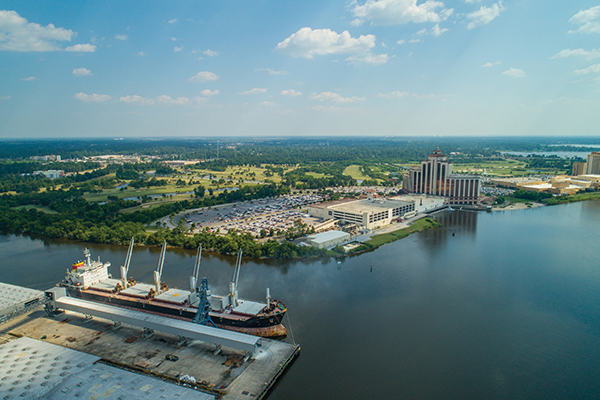
The Port of Lake Charles is a deepwater seaport in Lake Charles, Louisiana, located on the Calcasieu Ship Channel. It’s the nation’s 14th-busiest port district based on tonnage. The port manages the Calcasieu Ship Channel, which runs inland 36 miles and extends out into the Gulf of Mexico another 32 miles. The Port of Lake Charles’ official name is the Lake Charles Harbor & Terminal District, which encompasses 203 square miles.
The Port of Lake Charles, strategically positioned along the Gulf of Mexico, is renowned for its capacity to handle a wide array of cargo types. As the 10th-busiest deepwater port in the U.S. based on tonnage, the port is equipped to manage everything from bulk commodities to sophisticated project cargo. Common cargoes include lumber, alumina hydrate, bagged cement, rough (unmilled) rice, raw coke, rutile, calcine, sodium hydrosulfide and large industrial components. In addition, the port is a key player in the oil and gas sector, handling significant quantities of petroleum products. With facilities designed to support the chemical industry, the port safely and efficiently handles various chemical shipments.
Recently, the port completed a rehabilitation project to add strength and capacity at City Docks in the area of Berths 2 and 3. In addition, an ongoing five-year capital improvement project is underway to add capability and capacity to the port district — as well as to fully recover from the record damage sustained in 2020 from Hurricane Laura, the most destructive natural disaster in Lake Charles history.
Offshore wind power may become a significant asset for the port in the future. The Port of Lake Charles is located north of a federally designated offshore wind area in the Gulf of Mexico, and its properties include inland waterways and infrastructure that could serve wind-power manufacturing and/or handling.
“The Port and Calcasieu Ship Channel help generate fully two-thirds of the Lake Charles area’s GDP,” said Richert L. Self, Executive Director of the Port of Lake Charles. “A 2020 economic study we commissioned found that the cargo moving via the marine terminals located along the Calcasieu Ship Channel supported 158,485 jobs nationwide. Of those, 108,773 jobs are supported in Louisiana — about six percent of statewide employment — and 42,075 of them are supported in the Lake Charles MSA, which represents 45 percent of area non-farm jobs.”
Port of Morgan City, Louisiana
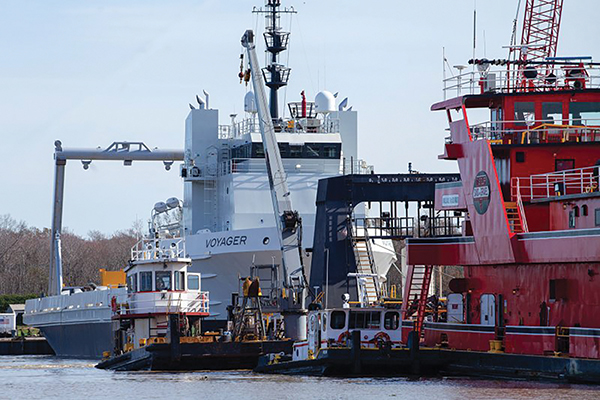
What does refitting an offshore supply vessel (OSV) for space tourism, operating a sprawling scrapyard, loading components onto a barge bound for Venture Global’s forthcoming LNG export facility in Plaquemines Parish and building berthing barges and submarine drydocks for the U.S. Navy all have in common? All are projects underway along the Morgan City, Louisiana waterfront. What’s more, they’re all possible, in large part, because of the Port of Morgan City’s 20-foot navigation channel, which extends from the sea buoy 20 miles offshore through the Atchafalaya River and Bayous Boeuf, Black and Chene.
Port business partners include InterMoor, which designs and fabricates offshore mooring suction piles, and Patterson Tubular Services, which transports pipes to Port Fourchon by barge rather than by truck. Performance Contractors has a huge yard near Amelia where modules are built and loaded onto barges for the Venture Global facility in Plaquemines Parish. Those modules are transported offshore, then up the Mississippi River. Conrad Shipyard is building a series of Yard, Repair, Berthing and Messing (YRBM) barges for the U.S. Navy, while Bollinger is building drydocks to support the Navy’s submarine maintenance program. Space Perspective chose Conrad in Morgan City for retrofitting an Edison Chouest Offshore OSV, now called the MS Voyager, which will send space tourists to the edge of space.
Port of Port Angeles, Washington
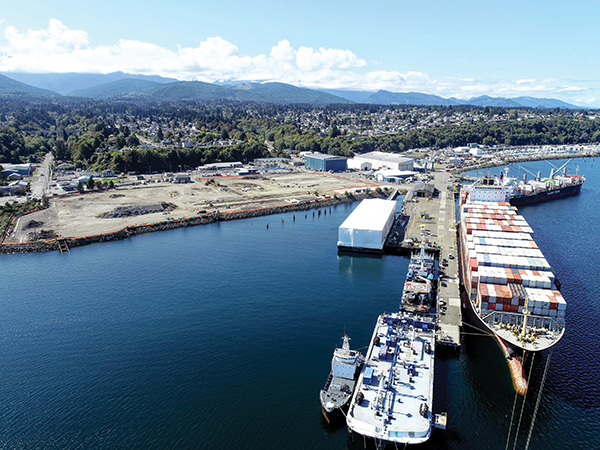
Located in the northwest corner of Washington State on the Strait of Juan de Fuca, the Port of Port Angeles serves the entirety of Clallam County, with the majority of facilities in and around Port Angeles. Facilities include two general aviation airports, seven marine terminals, two marinas containing a total of 700 slips, waterfront industrial area and industrial parks. In 2023, the port celebrated its 100th anniversary. Over the last 100 years, commodities evolved from exclusively forest products to more diversified products.
A new Foreign-Trade Zone (FTZ) is in final review with the U.S. Foreign-Trade Zones Board, and the port expects approval in 2025 for both the Port Angeles waterfront and Port Angeles airport areas. The port has become a global hub for moving products from both local and non-local sources to domestic and international markets. North across the Strait 20 miles is Vancouver Island, British Columbia. The Port of Port Angeles’ location brings business and jobs to Clallam County by linking the region to domestic and international markets, including Canada’s forest products industry. The new FTZ designation is expected to boost economic development by offering customs advantages and making international trade more accessible for local industries.
The Marine Trade Center, an 18-acre parcel of waterfront land, will be available for lease and development by maritime businesses in early 2025. The port anticipates these new businesses will provide skilled, prosperity-wage employment for maritime tradespeople throughout the region. Maritime jobs — in construction, repair and maintenance of military, commercial and recreational vessels — form a vital piece of the region’s economy. Once developed, the Marine Trade Center is expected to introduce 461 new jobs to the region, providing $17.6 million in new annual income and adding $1.3 million in tax revenue to local and state economies.
“This site is deliberately dedicated to the expansion of maritime trades,” said Port Executive Director Paul Jarkiewicz.
The project is an important part of the port’s efforts to diversify the city’s waterfront property to best service the maritime economy in Clallam County. The port has worked in partnership with the City of Port Angeles and Clallam County Economic Development Center to bring this ambitious project to fruition and significantly improve job opportunities and local wages for residents.
In October 2024, the port was awarded grant funds for 95 percent project funding from the Washington State Department of Transportation and the U.S. Environmental Protection Agency’s Clean Ports Program.
“The Port of Port Angeles is honored to receive these funds from the EPA’s Clean Ports Program,” said Port of Port Angeles Commission President Connie Beauvais. “This grant will empower the port to create environmental and economic benefits for the entire community. With this funding, the port will build new shore power infrastructure to reduce emissions from vessels at berth. We will also invest in groundbreaking zero-emissions cargo handling equipment that will allow the port to diversify the types of cargo we can handle. This is truly a unique opportunity for the port’s operations to become better for the local economy, our constituents and the environment.”
In November 2024, the port was also awarded $9 million from the U.S. Maritime Administration’s Port Infrastructure Development Program to purchase new low/zero-emissions cargo handling equipment (logstackers, material handlers and a bulk conveyor). The new equipment will greatly increase the port’s capacity to handle both inbound and outbound cargoes, including for new businesses attracted by the new Foreign Trade Zone status and Marine Trade Center development.
Port of Virginia
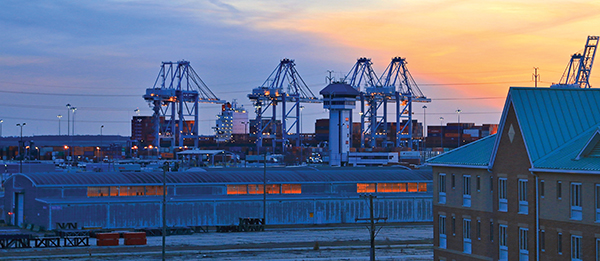
The Port of Virginia is a unique collection of six cargo terminals working in concert to move exports and imports to market by railroad, river barge and trucks. The port is built around the world’s largest natural deep-water harbor and currently stands as the third-largest container port on the East Coast. The port does more than service ships hauling cargo: it drives investment, job creation, revenue growth and connects Virginia to the world.
The Port of Virginia offers the deepest, obstruction-free shipping channels on the East Coast. It is the only U.S. East Coast port with Congressional authorization for 55-foot depth channels, and it can accommodate 10,000+ TEU vessels. It offers direct service to more than 45 countries worldwide and accommodates service offered by every major shipping line. The port provides fast and efficient on-dock rail connections to key inland markets and is located near two-thirds of the U.S. population within a day’s drive.
In early 2024, FreezPak Logistics, LLC, a provider of full-service cold and dry storage services, announced it is investing $77.5 million to construct a 245,000-square-foot cold storage facility in the City of Suffolk to serve the Mid-Atlantic region via The Port of Virginia. Virginia competed with Georgia and North Carolina for this project, which will create 80 new jobs.
In terms of sustainability, the port was the nation’s first to implement an ISO 14001-approved environmental standards program. In October 2024, the port announced that it is closer to its goal of eliminating all greenhouse gas emissions by 2040 thanks to a multimillion-dollar federal grant that will be used to buy electric equipment and the infrastructure needed to support it.
“This grant is truly transformative for our port and our community,” said Stephen A. Edwards, CEO and executive director of the Virginia Port Authority. “It will make our operations more efficient and sustainable, enhance our capabilities and allow us to continue making strides toward becoming the U.S. East Coast’s first net-zero port . T&ID

